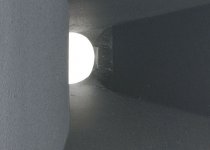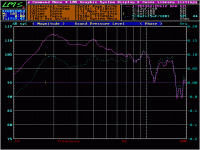The "distant" sound you are hearing might be the more "airy" presentation of a CD horn. Its a bit of an aquired taste but you will instantly notice the honk of a non CD horn if you ever go back.
Thanks frangus!
The waveguide is not on a baffle. My hope was that since the end/termination of the waveguide is quite large it would be ok in a box that is the exaxct size of the WG. Am I screwing up my listening tests by not terminating to a baffle?
Is there any way of making the distant sound come a bit closer and being more forward? EQ? I will have to make a couple of speakers that I can listen to for a while. Getting used to a new style of speakers I think is important before disliking them. I was a bit fast in my earlier judgement.
The waveguide is not on a baffle. My hope was that since the end/termination of the waveguide is quite large it would be ok in a box that is the exaxct size of the WG. Am I screwing up my listening tests by not terminating to a baffle?
Is there any way of making the distant sound come a bit closer and being more forward? EQ? I will have to make a couple of speakers that I can listen to for a while. Getting used to a new style of speakers I think is important before disliking them. I was a bit fast in my earlier judgement.
You could try a tractrix type horn like the small faital pro one that PE sells. The sound is more forward and focussed
Also try switching to the the titanium diaphragm from dayton. Im guessing they are interchangeable
Also try switching to the the titanium diaphragm from dayton. Im guessing they are interchangeable
Still no one has any comments on the rough +-1mm bumps in the first inch of the throat of the waveguide? This would seem like very bad in a waveguide to me.
There's good measurements here on the results of smoothing a throat. Different horn, same compression driver:
http://www.diyaudio.com/forums/multi-way/140190-jean-michel-lecleach-horns-155.html
The improvements are 6.5kHz and higher, which seems worthwhile, but is probably higher than the 'honk' range.
Anecdotal: It seems fairly common for horns throats to be a bit rough. Smoothing them out gives you a bit of satisfaction that you've made your system better, even if the results are not huge.
A few months ago I opted for brand X horns (rather than JBL) after looking at the throats of 2386 horns. New and 2nd hand, they all seemed a bit flawed, so I figured: why pay more if either option will require additional work to make it right? The photo here is a screen cap from the Parts Express page, so is presumably a good example. Some 2nd hand ones have clearly non-circular throats.
Attachments
The improvements are 6.5kHz and higher, which seems worthwhile, but is probably higher than the 'honk' range.
Below is a chart from Martin Collom's "High Performance Loudspeakers" book:
_________________________________________________
COLORATION
Boomy, 50 - 80 HZ
Chesty, plummy, 100 - 150 Hz
Boxy, hollow 150 - 300 Hz
Tube like, tunnelly 400 - 600 Hz
Cup like, honky, 700 - 1.2 kHz
Nasal, hard, 1.8 - 2.5 kHz
Presence, upper hardness, wiry 2.5 - 5.0 kHz
Sharp, metallic, sibilant 5.0 - 8.0 kHz
Fizzy, gritty, 10 -15 kHz
Also a link to another chart: Interactive Frequency Chart - Independent Recording Network
http://www.independentrecording.net/irn/resources/freqchart/main_display.htm
Last edited:
Fostex FE204
Your Fostex has plenty mids and highs.
The response of your CD/Horn combo is probably like the VIOLET plot below.
That is the RAW response of a Pyle PDS382 with a PYLE PH612 horn.
The bottom plot (BLUE) is when the combo is with passive EQ compensation.
For a start, you can try connecting a 5uF with a 18 ohms in parallel to your CD. This will roughly correct the tilt downwards. Cross it actively at 1K5 to 2K. See whether there's any improvement.
Attachments
Ok, so I tested a bit more today with the Fostex and waveguides.
I printed a Tractrix horn last night. According to some excel sheet it should load the driver down to 1742Hz and has reasonable input angle compared to the compression driver.
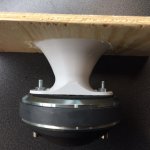
Very simple horn, 63mm long I think. 107mm diameter at the mouth.
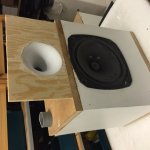
The complete speaker wont win any beauty contests, but it was enough to measure and listen.
With the QSC waveguide I got a very nice frequency response, but the sound is still a bit like a horn and somtimes I feel like voices get stuck in the waveguide. With this waveguide I crossover at 1500Hz LR24dB. There is a bit of EQ to the drivers to make it smooth.
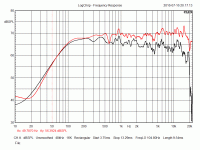
QSC+Fostex. 0 and 45 deg angle.
With the printed waveguide I get a very different behaviour in measurements and also in perceived sound. My print has the same character as the Fostex, quite in your face. They go together well. Songs that made the voices fall back a lot with the QSC stay up front with this one. Crossover is 3kHz LR24dB, which probably makes a difference. But I dont see the point in using the big QSC waveguide if I am not crossing over at 1500Hz or so.
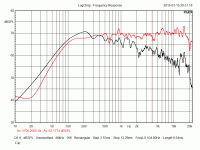
Printed tractrix+Fostex. 0 and 45 deg angle.
The printed horn measures more like a normal speaker. Maybe that is why I prefer it. The QSC sounds good, in some ways better than the printed horn, but for me it is too mellow. I can definitely see why people appreciate them, they do a lot of things very well.
Thanks everyone for helping me out!
I printed a Tractrix horn last night. According to some excel sheet it should load the driver down to 1742Hz and has reasonable input angle compared to the compression driver.

Very simple horn, 63mm long I think. 107mm diameter at the mouth.

The complete speaker wont win any beauty contests, but it was enough to measure and listen.
With the QSC waveguide I got a very nice frequency response, but the sound is still a bit like a horn and somtimes I feel like voices get stuck in the waveguide. With this waveguide I crossover at 1500Hz LR24dB. There is a bit of EQ to the drivers to make it smooth.

QSC+Fostex. 0 and 45 deg angle.
With the printed waveguide I get a very different behaviour in measurements and also in perceived sound. My print has the same character as the Fostex, quite in your face. They go together well. Songs that made the voices fall back a lot with the QSC stay up front with this one. Crossover is 3kHz LR24dB, which probably makes a difference. But I dont see the point in using the big QSC waveguide if I am not crossing over at 1500Hz or so.

Printed tractrix+Fostex. 0 and 45 deg angle.
The printed horn measures more like a normal speaker. Maybe that is why I prefer it. The QSC sounds good, in some ways better than the printed horn, but for me it is too mellow. I can definitely see why people appreciate them, they do a lot of things very well.
Thanks everyone for helping me out!
Increasing the frequency response in the 1 - 3 kHz range will increase the presence/forwardness/vocals of a loudspeaker. Even small increases of 1/2 dB have an effect.
i have the prv version mated with celestion cdx1730. it sounds excellent. clearly better than the seos 12 i have and the best 1 inch horn i have
You mean WG-35-25-B?for those who wants some more infos about this waveguide , the PRV WG35-35-B
Just checking in case there is a different model.
By the way, I'm doing a project where I've got some of those PRV waveguides and a bunch of these:
T-25 2-1/2" Paper Cone Tweeter 8 Ohm
In another thread there was a discussion about how bandpass loading a tweeter can achieve surprising results as a horn midrange, which is what got me thinking.
I'm grinding down the frames where necessary for cramming 6 of them as close to the apex as possible in a synergy-style midrange arrangement. I'm optimistic about the results. I mocked up the bandpass chamber off the horn and measured it. Looks like good output down to 500hz or lower should be possible.
I'm kindof winging this experiment. No clue how it will turn out.
Looking forward to seeing how much midrange output you can get from $18 worth of tweeters. If we pretend to believe the claim that they can handle 35w rms each, 210w of horn loaded midrange could potentially be surprisingly loud.
I think I might be able to get crossover point up to 2khz with the placement so close to the throat, which would relieve the strain on cheaper CDs like the D220ti that don't like to go too low.
Did you started your horn yet would love to see pics with those tweeters install can't wait to see pics was thinking of doing the same
Be careful with the glue on those. I had a heck of a time finding anything that would stick for long. The plastic they use behaves like teflon. Nothing sticks to it.
One thing that helped, in my case, was to use screws or bolts that go all the way INTO the waveguide. So the screws/bolts for the midrange actually secure the mounting plate to the horn. (In addition to the glue I used.)
One thing that helped, in my case, was to use screws or bolts that go all the way INTO the waveguide. So the screws/bolts for the midrange actually secure the mounting plate to the horn. (In addition to the glue I used.)
@zettairyouiki
are you sure of what your doing ???
this waveguide has been desing for one main 1 inch driver .
btw , let see what comes out ;-)
.
are you sure of what your doing ???
this waveguide has been desing for one main 1 inch driver .
btw , let see what comes out ;-)
.
zettairyouiki -
Why tweeters? You could instead use 1 3" or 4" midrange (seal the back if needed), and have fewer holes in the waveguide and less trouble. I've got that arrangement on a SEOS15 (in the "SmallSyns") and it works very well.
Though glue sticks find to a SEOS, Patrick/John reports the PRV is like gluing to teflon which can be a problem. Maybe connecting all those tweeter mounting panels to each other will keep them on the horn? Though you also need to maintain the seal to the walls.
Why tweeters? You could instead use 1 3" or 4" midrange (seal the back if needed), and have fewer holes in the waveguide and less trouble. I've got that arrangement on a SEOS15 (in the "SmallSyns") and it works very well.
Though glue sticks find to a SEOS, Patrick/John reports the PRV is like gluing to teflon which can be a problem. Maybe connecting all those tweeter mounting panels to each other will keep them on the horn? Though you also need to maintain the seal to the walls.
- Home
- Loudspeakers
- Multi-Way
- QSC HPR152i waveguides
